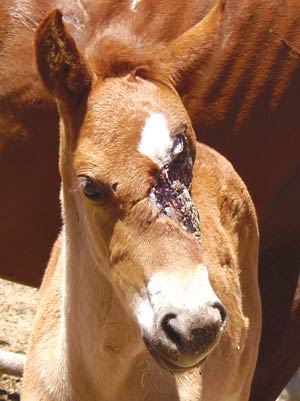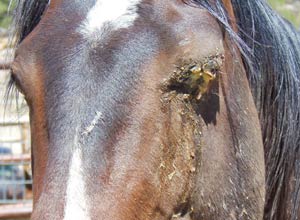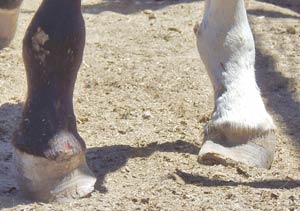Impounded animals show perils of feral horse problem
By Marley Shebala
Navajo Times
WINDOW ROCK, June 14, 2012



(Times photo - Glenda Rae Davis)
TOP: A filly with a large portion of her face severely damaged came in with a group of feral horses from Klagetoh, Ariz.
SECOND FROM TOP: A stallion with a severely infected eye came in with a group of feral horses from Klagetoh, Ariz.
THIRD FROM TOP: A horse with inverted, deformed front hooves came in with a group of feral horses from Klagetoh, Ariz.
The filly appeared unaware of its wound and trotted around the corral with its mother, which bore several scars over most of its body.
The filly also had scars on its scrawny little body.
Navajo Nation Resource Enforcement Ranger Sgt. Aureilia Nez said the filly and 11 other horses were impounded in the Klagetoh, Ariz., area on June 6.
Nez said that only five of the horses were branded.
All the horses, including the branded ones, were skittish around Nez, a sign that they had become feral, or wild, horses.
On the other side of the horses were individual corrals where three horses were enclosed.
A beautiful painted filly stood in one corral. She had been impounded from the Eastern Agency.
In another corral stood a dark brown stallion. It was branded and with a little coaxing from Nez it slowly walked towards her outstretched hand.
Its left eye was completely swollen and covered with oozing puss.
"If his owner comes in to claim him, we're citing him with animal cruelty," she said softly so she didn't scare the horse.
She said the rangers would also call the tribal veterinarian to treat the stallion's eye and castrate him, which would be paid by the owner before the stallion was released, along with $15 a day for boarding.
Nez estimated that the cost of the medical treatment would be more than $1,000.
In the stall next to the dark stallion was a skittish six-month-old filly that would not respond to coaxing from Nez.
Nez pointed to the filly's two front hooves, which were clearly deformed. The deformity forced the filly to stand with its legs turned in.
Scars and open wounds around were from the filly knocking her hooves against her ankles as she walked.
Nez said sadly that people don't see what the rangers see on almost a daily basis.
These horses would probably look beautiful and healthy from a distance or as you're driving by in your vehicle but once you get up close, you can see how they're suffering from a lack of water and food, she said.
The horses were scattered the far side of the corral but as soon as she turned on a water hose, the horses raced to drink water.
Nez said that the rangers try to feed and water the impounded horses daily but the program has limited funding, which only provides 100 bales of hay a month and that doesn't make it through the month. But the Agriculture Department is helping.
Steve Harris, a horsemanship trainer from Cottonwood, said during the 6th annual Navajo Nation Equine Expo at the fairgrounds that horses should be fed 10 pounds of hay daily.
Nez said at the beginning of the month, the rangers impounded 162 horses from the Dilkon area.
Unlike the Klagetoh horses, the Dilkon horses were impounded for three days instead of the legally mandated five days.
Nez explained that Klagetoh Chapter passed a resolution for horse roundup that specifically asked that the horses be held for three days instead of five days, which is a legal option for chapters.
She said that most of the Dilkon horses were never claimed and were sold to a buyer who transported them to Mexico to a horse slaughterhouse.
She estimated that the horses were probably sold for $20 to $30 a head.
If no one claims the dark stallion with the infected eye, it will probably be given to the buyer, she said.
The fifth day for the Klagetoh horses was Sunday.
Nez said that people often ask why the rangers don't sell the horses they impound to reservation residents instead of to a buyer who takes them to slaughterhouses in Mexico.
She said selling to locals created problems between the buyers and individuals who claimed to be the original owners.
On Wednesday, Nez said she was pretty sure that all 12 of the Klagetoh horses had been sold to the same buyer that took horses to Mexico.
She said that she wasn't at the impoundment yard on Monday because she and other rangers were called to the fire in Wide Ruins to help evacuate people.

